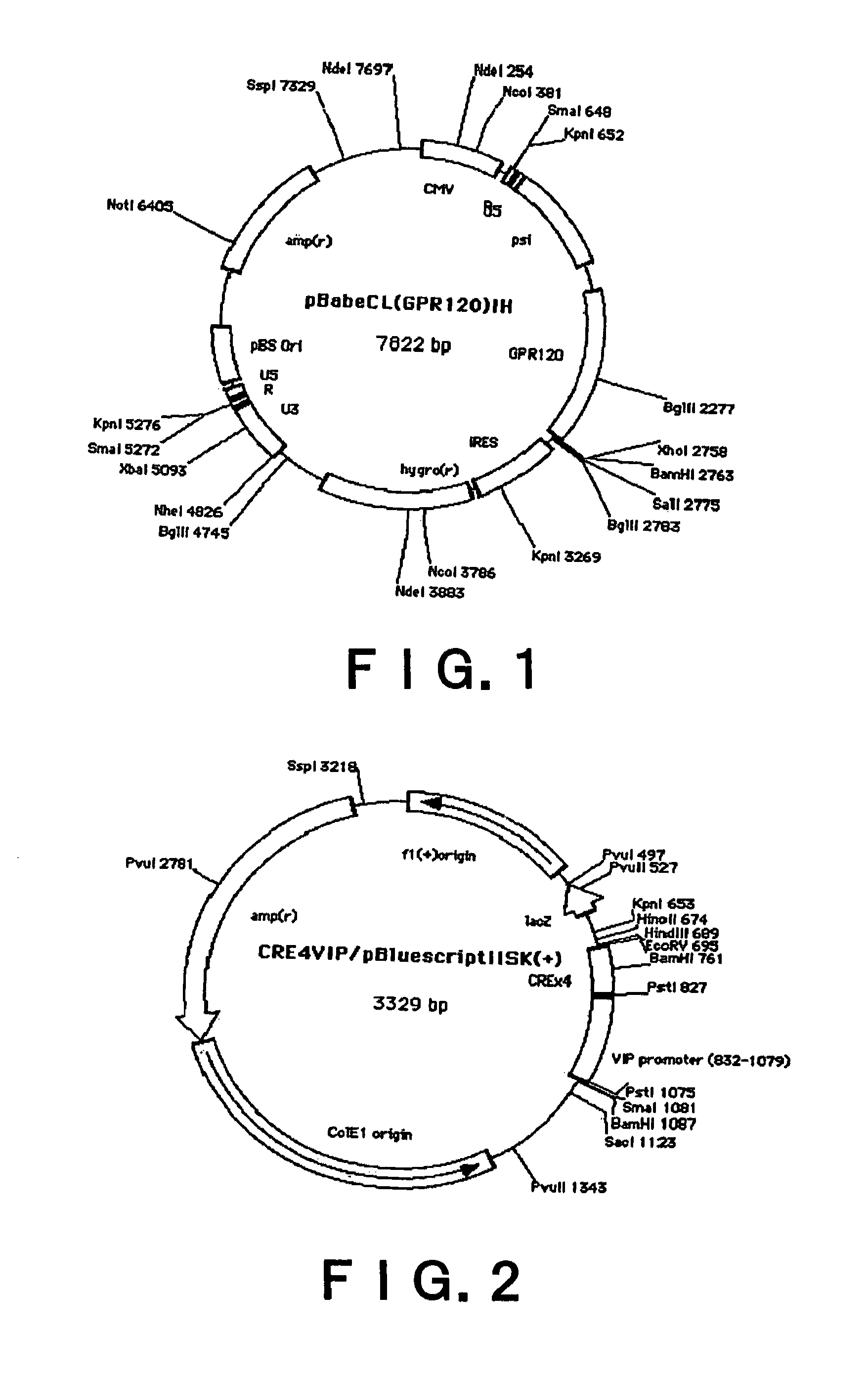Method for screening of substance which alter GPR120-mediated cell-stimulating activities
a technology of gpr120 and cell-stimulating activity, which is applied in the field of screening of substances whose gpr120-mediated cell-stimulating activity is altered, can solve the problems of difficult prediction of the type of signal transduction system activated by orphan gpcr after responding to a ligand, difficulty in predicting the ligand for each of orphan gpcrs, and difficulty in predicting the tissue in which a ligand
- Summary
- Abstract
- Description
- Claims
- Application Information
AI Technical Summary
Benefits of technology
Problems solved by technology
Method used
Image
Examples
example 1
Preparation of a Polynucleotide Encoding GPR120
[0203](1) Preparation of a Polynucleotide Encoding Human GPR120
[0204]For isolation of a polynucleotide encoding human GPR120 (optionally referred to simply as GPR120 or hGPR120 hereinafter), a pair of primers, a 5′-primer (5′-GATATCGCCGCCACCATGTCCCCTGAATGCGCGCGGGCA-3′) (SEQ ID NO 7) and a 3′-primer (5′-GATATCTTAGCCAGAAATAATCGACAAGTC-3′) (SEQ ID NO 8), were designed based on the nucleic acid sequence of 1086 bp of SEQ ID NO 1.
[0205]A template cDNA was obtained by reverse transcription of RNA prepared from human colon cancer cell line, Caco-2 cells. Specifically, total RNA was extracted from Caco-2 cells (ATCC) cultured in a 75 cm2 flask using RNeasy Mini Kit (QIAGEN, Co) according to the manual. Then reverse transcription was carried out using TaqMan Reverse Transcription Reagents (Applied Biosystems, Co.) at 25° C. for 10 min, at 48° C. for 60 min, and at 95° C. for 10 min. Using the cDNA obtained as a template, PCR reaction was carried...
example 2
Preparation of a Retrovirus Vector Plasmid
[0208]By cleaving pBabe Puro (Morgenstern, J. P. and Land, H. Nucleic Acid Res. 18(12):3587-96, 1990) (SEQ ID NO 11) with SalI and ClaI, SV40 promoter-puro(r) domain was removed and terminals were blunted using Klenow fragment (Takara Shuzo, Co., Ltd.). Into this site, IRES-hyg(r) domain which is pIREShyg (Clontech, Co.) cleaved out with NsiI and XbaI and blunted with T4 polymerase (Takara Shuzo, Co., Ltd.) was inserted and pBabeXIH was obtained.
[0209]This BabeXIH was cleaved with SspI and BamHI, and 5′-LTR-packaging signal was deleted. Into this site, 5′-LTR-CMV promoter-packaging signal cleaved out from pCLXSN (IMGENEX Co.) with SspI and BamHI was inserted and pBabeCLXIH was obtained.
example 3
Preparation of a Retrovirus Vector Plasmid for Introduction of Genes for GPR120 and mGPR120
[0210]The retrovirus expression plasmid pBabeCLXIH obtained in Example 2, was cleaved with a restriction enzyme, HpaI. Into this site, cDNA encoding GPR120 cleaved out using EcoRV, from GPR120-pCR2.1 obtained in Example 1 (1) was inserted and pBabeCL(GPR120)IH was obtained (FIG. 1). Similarly, pBabeCL(mGPR120)IH was obtained using mGPR120-pCR2.1 obtained in Example 1 (2).
PUM
| Property | Measurement | Unit |
|---|---|---|
| temperature | aaaaa | aaaaa |
| temperature | aaaaa | aaaaa |
| temperature | aaaaa | aaaaa |
Abstract
Description
Claims
Application Information
 Login to View More
Login to View More - R&D
- Intellectual Property
- Life Sciences
- Materials
- Tech Scout
- Unparalleled Data Quality
- Higher Quality Content
- 60% Fewer Hallucinations
Browse by: Latest US Patents, China's latest patents, Technical Efficacy Thesaurus, Application Domain, Technology Topic, Popular Technical Reports.
© 2025 PatSnap. All rights reserved.Legal|Privacy policy|Modern Slavery Act Transparency Statement|Sitemap|About US| Contact US: help@patsnap.com



